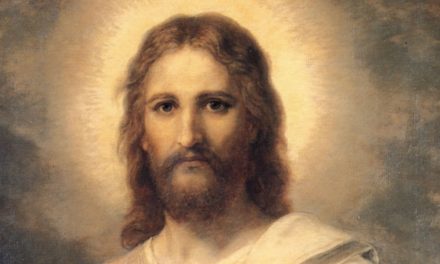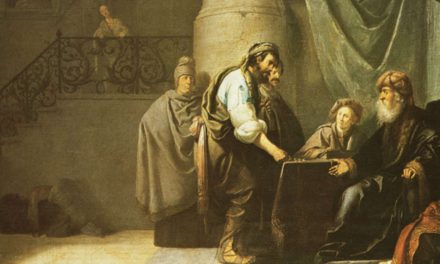Louder Than Words — Jesus Puts His Words Into Action
Editor’s Note — Part 5 of Jesus, Kingdom Builder, a 13-part study of St. Matthew’s Gospel by Dr. Sri. The series will run every other Friday.

Photography © by Andy Coan
It has often been said that “actions speak louder than words”. This maxim is especially true for Jesus in the whirlwind of events following the famous “Sermon on the Mount.”
In this great sermon, Jesus challenged Israel to be “light to the world” and confronted the exclusive and nationalistic tendencies within the Judaism of His day. However, while His words certainly left a deep impression on many, they were only a prelude to the more dramatic actions which followed when Jesus came down from that mountain. Matthew 8-9 records for us how Jesus immediately put His words into action in 10 miracles which shouted out a message that was much louder than anything He said in His sermon. In remarkable fashion, Jesus cured a leper, healed a paralytic, restored sight to the blind, raised a child from the dead, and expelled demons. At the end of this tour de force, the crowds marveled, saying, “Never was anything like this seen in Israel” (Mt. 9:33).
What was Jesus saying in these 10 mighty deeds? Was Jesus trying to establish Himself as some type of first-century faith healer? Did He perform these miracles simply to impress people or perhaps to prove His divinity? Looking at these powerful actions through the lenses of first-century Judaism, we will see how practically every move Jesus made was charged with great symbolic meaning and played a key part in His plan of building His kingdom.
John the Baptist was someone who had the same question we do. He was wondering what the meaning was behind Jesus’ mighty works. John heard about these miracles while he was in prison for having preached against the wicked deeds of King Herod. In this time of persecution and suffering, John’s faith was tested, and he had some uncertainties about whether Jesus really was the Messiah. John might have been wondering, “If Jesus really is the Messiah-king, why am I still suffering here in prison? Why hasn’t He freed me from Herod’s terror?”
Wanting some reassurance from Jesus, John sent some of his own disciples to ask Jesus, “Are you he who is to come, or shall we look for another?” (Mt. 11:3). Jesus gave this answer to them:
“Go and tell John what you hear and see: the blind receive their sight and the lame walk, lepers are cleansed and the deaf hear, and the dead are raised up, and the poor have good news preached to them” (Mt. 11:4-5).
What kind of response was that? How would these words have answered John’s important question? At first glance, Jesus does not seem to be very helpful. Yet those who know the Old Testament—and John the Baptist certainly did! — would realize that Jesus was echoing a prophecy from Isaiah concerning the restoration of Israel:
“Behold, your God will come . . . He will come and save you. Then the eyes of the blind shall be opened, and the ears of the deaf unstopped; then shall the lame man leap like a hart, and the tongue of the dumb sing for joy” (Is. 35:4-6).
Jesus basically said to the disciples, “Go tell John what you have seen and heard — in other words, tell him Isaiah 35 has come to fulfillment in me.” That certainly would have provided the reassurance John was seeking. And this provides us with an insight into how Jesus interpreted His own actions: They were signs of Israel’s restoration. In these healings, Jesus was symbolically announcing the arrival of the long-awaited kingdom.
Don’t Make Essene!
What is also significant is the type of people Jesus healed. Jews who suffered from leprosy and other illnesses would have been the outcasts in Jesus’ day. They were excluded from society because they were ritually unclean. Only the pure and the physically whole were considered full Israelites.
This attitude was reflected in the writings of one Jewish sect known as the Essenes. Consider the following fragment from an ancient Essene source (commonly called the Dead Sea Scrolls) which lists the type of people who were excluded from office in their community:
- Neither the blind nor the lame
- Nor the deaf nor the dumb
- Nor the lepers, nor those whose flesh is blemished
- Shall be admitted to the council of the community.[1]
In this light, we see that Jesus’ healing ministry went far beyond curing bodily ailments. Jesus was bringing these outsiders in. In healing them physically, He was restoring them socially and religiously back into Israelite society. In this way, Jesus was symbolically showing how all the traditional outcasts were among the first to be included in His kingdom.
Reach Out and Touch Someone
Let’s look at the leper who knelt down before Jesus and begged Him to make him clean (cf. Mt. 8:1-4). Leprosy was the most dreaded disease in ancient Judaism. Lepers were banished from society. They were considered untouchables who had to announce their approach by saying “Unclean, unclean!” If a Jew touched a leper, he himself would become ritually unclean and would have to go through a complex process of ritual purification before being fit for Temple worship again.
Yet when this leper asked Jesus to heal him, Jesus did the unthinkable. He stretched out His hand and touched the man! But something amazing happened. Instead of becoming ritually defiled Himself, Jesus’ holiness overpowered the uncleanness of the leper, and the leper was cured. It was not Jesus who was made unclean by touching the leper, but the leper was made clean by touching Jesus!
In another episode, a woman suffering from a hemorrhage for 12 years desperately approached Jesus for healing. But she had to do so in a secretive way. With this ailment, the woman daily faced not only the physical danger of blood loss, but also the cultural shame of ritual uncleanness (cf. Lev. 15:25-30). She knew that any contact with Jesus would make Him ritually unclean as well. Nevertheless, she said to herself, “If I only touch his garment, I shall be made well” and dared to come up from behind and touch the fringe of His garment in the hope of being cured (Mt. 9:21).
A first-century Jew would have been shocked by such a bold action, and would have assumed that Jesus became defiled by her uncleanness. Once again, however, the opposite occurred. Instead of Jesus’ becoming contaminated by her ritual impurity, the woman was healed instantly by the power of Jesus. Jesus had a healing power that far exceeded anything ever seen in the Old Testament. His holiness transformed the unholy. His cleanness wiped out the uncleanness. His sinlessness even purified sin.[2]
Forgiving Sins
As His fame spread throughout the region of Galilee, crowds flocked to Jesus and begged Him for help. The sick asked Jesus for cures. Blind men cried out to Him for sight. Gentile officials asked Him to heal their children.
At the same time, Matthew tells the story of a paralyzed man who could not draw near to Jesus. His generous friends, however, carried the paralytic to Jesus for help. Jesus, in turn, gave the man something much greater than anything he probably ever imagined. Not only did Jesus cure the man of his physical disability and give him the strength to stand up and walk, but Jesus also bestowed on him the power to walk again spiritually by forgiving his sins:
“And behold, they brought to him a paralytic, lying on his bed; and when Jesus saw their faith he said to the paralytic, ‘Take heart, my son; your sins are forgiven’” (Mt. 9:2).
By forgiving this man’s sins, Jesus deliberately engaged in an action that was quite provocative. It shouted out good news, but in a way that might have alarmed some of those who witnessed this amazing event.
On one hand, forgiveness of sins was one of the chief signs of the new covenant. Recall how the Jews interpreted their suffering under foreign domination as resulting from their own sinfulness (cf. Deut. 28:15-68; Dan. 9:1-19). That’s why several prophecies from the Old Testament spoke of a new covenant in which God would free Israel from their oppression and do so by freeing Israel from their sins (cf. Jer. 31:31-34; 33:4-11; Is. 43:25; Ezek. 36:25-27; Dan. 9:24). Forgiveness of sins and Israel’s restoration went hand in hand. So when Jesus forgave sins, He was not simply bestowing private spiritual blessings on select individuals. Rather, He was announcing the fulfillment of everything the Jews were hoping for. By offering forgiveness of sins, Jesus was symbolically announcing the dawn of the new covenant and the arrival of the long-awaited kingdom. Indeed, this was good news!
Replacing the Temple
But not everyone took it that way. Instead of rejoicing, the scribes accused Jesus of blasphemy (Mt. 9:3). They believed that only God could forgive sins and He did so through the Temple priests and the Temple sacrifices. “Who does this man think He is forgiving sins apart from the Temple?” they would ask.
Thus, in this simple action of saying “your sins are forgiven,” Jesus claimed to do what only God could do. And He was saying to the Jews, “What you used to get at the Temple in Jerusalem and through the levitical priesthood you can get right here, right now, with me.” In one broad stroke, Jesus bypassed the Temple system altogether and proclaimed Himself the source of forgiveness of sins. Jesus made Himself the new Temple, hinting that the days of the Temple in Jerusalem might be coming to an end. No wonder the scribes were so upset!
An Open Table
In addition to healing the sick and forgiving peoples’ sins, Jesus was busy building His kingdom even while eating at the dinner table. All throughout His ministry, Jesus invited sinners and other outcasts of society to share a meal with Him. This practice of open-table fellowship, however, was much more than a gesture of warm hospitality. It was a revolutionary action which sparked much controversy. Consider this scene in Matthew 9:
“And as he sat at table in the house, behold, many tax collectors and sinners came and sat down with Jesus and his disciples. And when the Pharisees saw this, they said to his disciples, ‘Why does your teacher eat with tax collectors and sinners?’” (Mt. 9:10-11).
Why were the Pharisees so upset? To understand their perspective, we need to know a little about the sacredness of meals in the first century.
More Than a Mouthful
We can’t overestimate the importance of eating with “the right people” in first-century Judaism. In ancient Israel, meals were sacred. To invite someone to a meal was to practically invite them into your family.
In our modern society, we can sit down in a fast-food restaurant and have a meal alongside complete strangers and not think much about it. However, the ancient Israelites considered eating a meal with others a rather serious affair. Shared food and drink symbolized a shared life. They forged covenant bonds and were interpreted as establishing familial relationships — so much so that two enemies could seal a peace agreement by sharing a meal and then, afterwards, even refer to each other as brothers! (cf. Gen. 26:26-31; 31:54-55). That’s why the Jews generally ate only with extended family members or fellow Israelites of a similar social and religious class. Most loyal Jews never ate with pagans or sinners.
More than any other group, the Pharisees gave special attention to table fellowship laws. In their desire to remain separate from anything or anyone unholy, the Pharisees taught that Jews should only eat with fellow Jews who were in good standing. In fact, 229 of their 341 laws dealt with table fellowship alone!
This helps explain why the Pharisees were so scandalized when Jesus ate with the sinners and tax collectors. How could Jesus sit at table with grave sinners who were ritually unclean and outside the covenant? How could Jesus share a meal with the tax collectors — the traitors who collaborated with Rome and Herod and went around collecting the taxes for the enemy?
So when Jesus dined at table, He seemed to be celebrating His kingdom with all the wrong people. A true Jew would never think of doing such a thing.
The Doctor’s Orders
However, in these eloquent actions, Jesus was making a bold statement. He deliberately chose these controversial dining partners to highlight the universality of His mission and to demonstrate His power to transform sinners and welcome them back into covenant fellowship.
Notice how Jesus responded to the Pharisees’ complaint: “It is not the healthy who need the doctor, but the sick” (Mt. 9:12, New Jerusalem Bible). Just as a doctor must have contact with the sick, so does Jesus draw near to sinners to restore them to spiritual health. In this sense, His practice of eating with sinners and tax collectors signified a greater miracle than His healing of blindness, leprosy, and other illnesses. Without saying a word, Jesus symbolically restored these outcasts to God’s covenant family and announced a surprise cast of members in the kingdom He was building. Once again, His actions spoke louder than His words.
Footnotes:
[1] N. T. Wright, Jesus and the Victory of God (Minneapolis: Fortress, 1996), 191.
[2] M. Borg, The Politics of Holiness, (Harrisburg: Trinity Press, 1988), 148.
Questions for Discussion:
- St. Francis of Assisi is often quoted as saying, “Preach the Gospel always, and when necessary use words.” What do you think is the proper balance between using words and actions in sharing the Gospel in today’s world? How might the way Jesus used words and actions in Matthew 5-9 shed light on this question?
- As we have seen, many first-century Jews did not want to associate with non-Jews and other grave sinners. In what ways might Catholics today be tempted to fall into a similar trap? In what ways can you challenge yourself to extend fellowship to those who might not share the same values, interests, and beliefs as you? How might such fellowship lead others to Jesus and the Catholic Church?
- While Jesus never condones sinful actions, the Gospels do tell of Jesus’ constantly welcoming sinners and warmly inviting them into His table fellowship. How might Jesus’ outreach to sinners serve as a model for the Christian’s relationship with unbelievers and those who are not living a Christian life?
Acknowledgement:
Reprinted with permission from the May 1999 issue of Lay Witness magazine. © 1999 Catholics United for the Faith / www.cuf.org/Laywitness/index.asp
Please help us in our mission to assist readers to integrate their Catholic faith, family and work. Share this article with your family and friends via email and social media. We value your comments and encourage you to leave your thoughts below. Thank you! – The Editors













